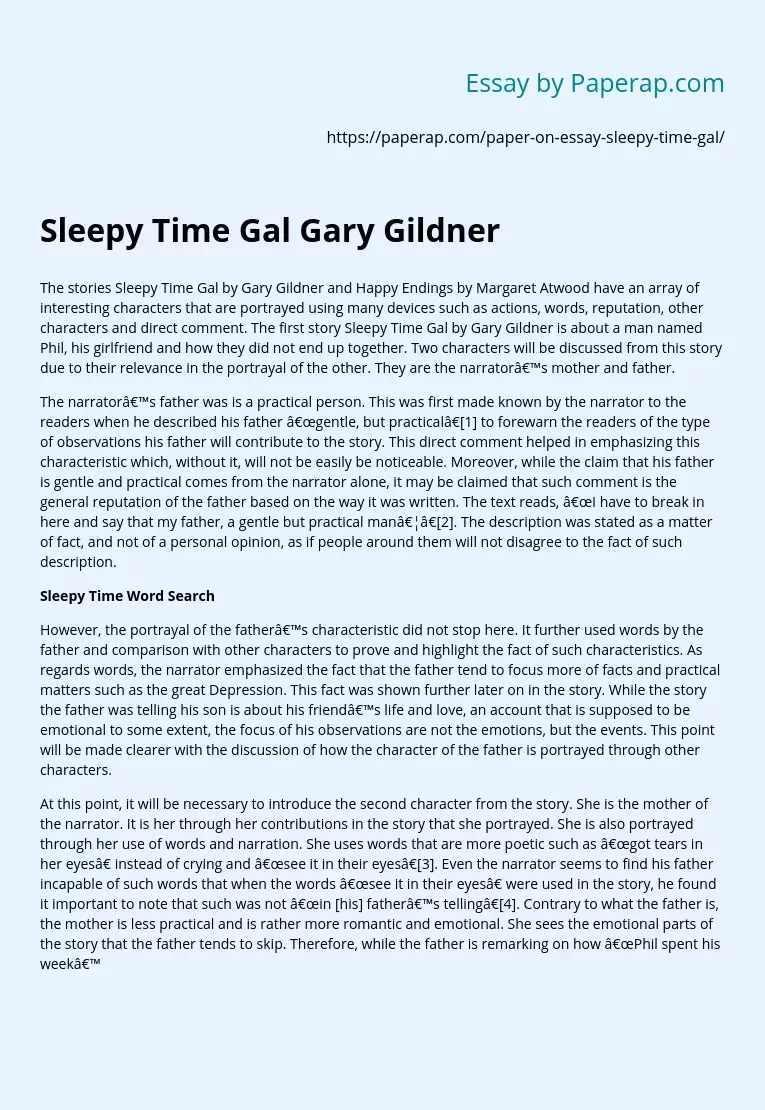Sleepy Time Gal Gary Gildner
The stories Sleepy Time Gal by Gary Gildner and Happy Endings by Margaret Atwood have an array of interesting characters that are portrayed using many devices such as actions, words, reputation, other characters and direct comment. The first story Sleepy Time Gal by Gary Gildner is about a man named Phil, his girlfriend and how they did not end up together. Two characters will be discussed from this story due to their relevance in the portrayal of the other. They are the narrator’s mother and father.
The narrator’s father was is a practical person. This was first made known by the narrator to the readers when he described his father “gentle, but practical”[1] to forewarn the readers of the type of observations his father will contribute to the story. This direct comment helped in emphasizing this characteristic which, without it, will not be easily be noticeable. Moreover, while the claim that his father is gentle and practical comes from the narrator alone, it may be claimed that such comment is the general reputation of the father based on the way it was written.
The text reads, “I have to break in here and say that my father, a gentle but practical man…”[2]. The description was stated as a matter of fact, and not of a personal opinion, as if people around them will not disagree to the fact of such description.
Sleepy Time Word Search
However, the portrayal of the father’s characteristic did not stop here. It further used words by the father and comparison with other characters to prove and highlight the fact of such characteristics.
As regards words, the narrator emphasized the fact that the father tend to focus more of facts and practical matters such as the great Depression. This fact was shown further later on in the story. While the story the father was telling his son is about his friend’s life and love, an account that is supposed to be emotional to some extent, the focus of his observations are not the emotions, but the events. This point will be made clearer with the discussion of how the character of the father is portrayed through other characters.
At this point, it will be necessary to introduce the second character from the story. She is the mother of the narrator. It is her through her contributions in the story that she portrayed. She is also portrayed through her use of words and narration. She uses words that are more poetic such as “got tears in her eyes” instead of crying and “see it in their eyes”[3]. Even the narrator seems to find his father incapable of such words that when the words “see it in their eyes” were used in the story, he found it important to note that such was not “in [his] father’s telling”[4]. Contrary to what the father is, the mother is less practical and is rather more romantic and emotional. She sees the emotional parts of the story that the father tends to skip. Therefore, while the father is remarking on how “Phil spent his week’s pay on a new shirt and tie, the first one he ever owned….” the night before Phil’s girlfriend left for college, his mother is talking about how “[t]he women got tears in their eyes when Phil played her song…”[5] Oftentimes, their statements come one after the others’, thus making the difference between their perspectives more marked and noticeable, making each of them a perfect tool to portray the other.
This brings us to the second story Happy Endings, which is about happy endings that are not endings because they turn sour again for the characters in the story until they die. In this story, the most interesting character to discuss is the narrator.
There are many characters used in the story. There are John, Mary, Madge, John, James and Fred. However, they are not portrayed in the story in the sense that they are not relevant as characters. They are merely tools to portray the narrator. Again, they were just “used”. They were only used to portray the narrator’s view about happy endings. There is no happy ending. Just when the characters finally have a happy ending of their own, the narrator will twist it to make it sour, sad and complicated. This change may still end in another happy ending, but that second happy ending will again be made sour, sad and complicated. This cycle continues until the character dies. Such belief shows cynicism on the part of the narrator and portrays him to be an unhappy person. He is one who believes that what happy ending he may have will not last because he does not believe in happy endings. The only true ending is death and all the others are fakes. For him, happy endings are just fake endings “either deliberately fake, with malicious intent to deceive, or just motivated by excessive optimism if not by downright sentimentality”[6].
Her character is also portrayed by the words he used in telling John, Mary, Madge, John, James and Fred. Their stories were told through a series of events as if these events ordinarily happen in everyone’s lives, devoid of any emotion and sentimentality. They are just facts about certain people’s lives. Each story ends with a happy ending, at least before they turn sour again, but these happy endings are not told in a happy way unlike how other happy endings would be told.
Sleepy Time Gal Gary Gildner. (2019, Dec 05). Retrieved from https://paperap.com/paper-on-essay-sleepy-time-gal/

